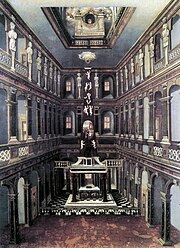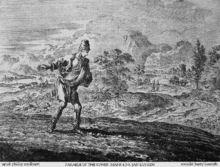Gleichwie der Regen und Schnee vom Himmel fällt, BWV 18
| Gleichwie der Regen und Schnee vom Himmel fällt | |
|---|---|
BWV 18 | |
| Church cantata by J. S. Bach | |
 | |
| Occasion | Sexagesima |
| Cantata text | Erdmann Neumeister |
| Bible text | Isaiah 55:10–11 |
| Chorale | by Lazarus Spengler |
| Performed | |
| Movements | 5 |
| Vocal |
|
| Instrumental |
|
Gleichwie der Regen und Schnee vom Himmel fällt (Just as the rain and snow fall from heaven),[1] BWV 18,[a] is an early church cantata by Johann Sebastian Bach. He composed it in Weimar for the Sunday Sexagesimae, the second Sunday before Lent, likely by 1713.
History and words
Bach worked for the court in Weimar from 1708. On 2 March 1714 Bach was appointed concertmaster of the Weimar court capelle of the co-reigning dukes Wilhelm Ernst and Ernst August of Saxe-Weimar. As concertmaster, he assumed the principal responsibility for composing new works, specifically cantatas for the Schlosskirche (palace church), on a monthly schedule.[2] Bach composed this cantata for the second Sunday before Ash Wednesday, called Sexagesima. The prescribed readings for the Sunday were taken from the Second Epistle to the Corinthians, "God's power is mighty in the weak" (2 Corinthians 11:19–12:9), and from the Gospel of Luke, the parable of the Sower (Luke 8:4–15).[3]
The cantata is based on a text by Erdmann Neumeister written for the Eisenach court and published in Gotha in 1711 in the collection Geistliches Singen und Spielen (Sacred singing and playing),[4] which had been set to music by Georg Philipp Telemann.[3] The text cites Isaiah in the second movement, "For as the rain cometh down, and the snow from heaven, … So shall my word be ..." (Isaiah 55:10–11), related to the Gospel about God's word compared to seed.[5] In the third movement, the poet combines warnings of the dangers to God's word in the style of a sermon with four lines of prayer from a litany by Martin Luther. The closing chorale is the eighth stanza of Lazarus Spengler's hymn "Durch Adams Fall ist ganz verderbt" (1524).[3] [6]
The cantata falls relatively early in Bach's chronology of cantata compositions. It was possibly composed for 24 February 1715, but more likely a year or two earlier.[3] Christoph Wolff states: "The original performing material has survived and allows us to date the work to 1713".[4] Bach performed the cantata again in Leipzig in 1724, with an expanded scoring in a different key.[3] It was then probably performed in the same service as the newly composed [[[Leichtgesinnte Flattergeister, BWV 181|Leichtgesinnte Flattergeister, BWV 181]]] Error: {{Lang}}: text has italic markup (help).[7]
Scoring and structure
Like other cantatas written in Weimar, the cantata is scored for a small ensemble, composed of soprano, tenor, and bass soloists, a four-part choir, four violas, cello, bassoon and basso continuo.[3] The setting for four violas is unusual.[5] In a similar orchestration, the Brandenburg Concerto No. 6 also omits violins. The second version of this cantata for a performance in Leipzig adds two recorders, which double viola I and II an octave higher. John Eliot Gardiner compares the effect to a four-foot stop on a pipe organ.[8] The cantata begins in G minor in the Weimar version, in A minor in the Leipzig version.
The cantata, which opens with a sinfonia, contains five movements.[3]
- Sinfonia
- Recitative (bass): Gleichwie der Regen und Schnee vom Himmel fällt
- Recitative and chorale (litany) (tenor, bass, choir): Mein Gott, hier wird mein Herze sein – Du wollest deinen Geist und Kraft
- Aria (soprano): Mein Seelenschatz ist Gottes Wort
- Chorale: Ich bitt, o Herr, aus Herzensgrund
Music

The keys in this section refer to the Weimar version, although the recording by Masaaki Suzuki, with commentary by Klaus Hofmann, uses the Leipzig keys. Hofmann notes the work's "Lutheran character", quoting Luther's litany inserted in the third movement, and sees it as a "recitative study, exploring the secco recitative of the Italian opera, introduced by Erdmann Neumeister, and also the accompagnato with rich instrumental accompaniment.[5] Gardiner finds all three cantatas for the occasion, dealing with God's word, "characterised by his vivid pictorial imagination, an arresting sense of drama, and by music of freshness and power that lodges in the memory".[8]
The cantata opens with a sinfonia in G minor, which illustrates falling rain and snow in descending phrases. In da capo form, is reminiscent both of a chaconne and a concerto. The four violas and continuo, with bassoon and cello parts specified, create an unusual sound,[5] termed "magically dark-hued sonority" by Gardiner.[8]
The quotation from Isaiah is sung by the bass, the vox Christi (voice of Christ), in a secco recitative.[3] This is Bach's first adaptation of recitative in a church cantata, not following operatic patterns, but "a lucid presentation of the text in a dignified, highly personal style".[8]
The central movement is unique in Bach's cantatas, the choir soprano interrupts the prayer of the male soloists four times, followed by a conclusion of the full choir "Erhör uns, lieber Herre Gott!" (Hear us, dear Lord God!).[1][3] The recitatives are marked adagio in E-flat major, while the interspersed litany is presented dramatically (allegro in C minor).[5] Gardiner compares the imagery of the recitatives: "all adds up to a vivid, Brueghel-like portrayal of rural society at work – the sower, the glutton, the lurking devil, as well as those pantomime villains, the Turks and the Papists. He compares the movement to Telemann's setting of the same text and states:
On the other hand here is Bach, seeming to relish the contrast between archaic litany and his new 'modern' recitative style in which he empowers his two male soloists to voice personal pleas for faith and resolution in the face of multiple provocation[s] and devilish guile, with increasingly virtuosic displays of coloratura, ever-wider modulations and extravagant word-painting on 'berauben' (to rob), 'Verfolgung' (persecution) and 'irregehen' (to wander off course).[8]
The only aria, for soprano in E-flat major, is accompanied by the four violas in unison. The cantata closes with a four-part setting of Spengler's hymn stanza,[9] Bach's first of many to come as the typical conclusion of his cantatas.[8]
Recordings
- J.S. Bach: Kantaten 18 · 152, Jürgen Jürgens, Monteverdi-Chor, Leonhardt-Consort, Agnes Giebel, Bert van t'Hoff, Jacques Villisech, Telefunken, 1964
- J.S. Bach: Kantaten Gleichwie der Regen und Schnee vom Himmel fällt BWV 18; Nun komm, der Heiden Heiland BWV 62, Erhard Mauersberger, Thomanerchor, Gewandhausorchester, Adele Stolte, Peter Schreier, Theo Adam, Eterna 1967
- J.S. Bach: Das Kantatenwerk · Complete Cantatas · Les Cantates, Folge / Vol. 5, Nikolaus Harnoncourt, Wiener Sängerknaben, Chorus Viennensis, Concentus Musicus Wien, soloist of the Wiener Sängerknaben, Kurt Equiluz, Max van Egmond, Teldec 1971
- J.S. Bach: Complete Cantatas Vol. 2, Ton Koopman, Amsterdam Baroque Orchestra & Choir, Barbara Schlick, Kai Wessel, Christoph Prégardien, Klaus Mertens, Antoine Marchand 1995
- J.S. Bach: Cantatas Vol. 5 – BWV 18, 143, 152, 155, 161, Masaaki Suzuki, Bach Collegium Japan, Midori Suzuki, Makoto Sakurada, Peter Kooy, BIS 1997
- Bach Edition Vol. 5 – Cantatas Vol. 2, Pieter Jan Leusink, Holland Boys Choir, Netherlands Bach Collegium, Marjon Strijk, Robert Getchell, Bas Ramselaar, Brilliant Classics 1999
- Bach Cantatas Vol. 20: Naarden / Southwell / For Septuagesima / For Sexagesima, John Eliot Gardiner, Monteverdi Choir, English Baroque Soloists, Gillian Keith, James Gilchrist, Stephan Loges, Soli Deo Gloria 2000
- J.S. Bach: Cantatas for the Complete Liturgical Year Vol. 6 (Sexagesima and Estomihi Sundays): "Wie schon leuchtet der Morgenstern" – Cantatas BWV 18 · 23 · 1, Sigiswald Kuijken, La Petite Bande, Siri Thornhill, Petra Noskaiová, Marcus Ullmann, Jan van der Crabben, Accent 2007
- J.S. Bach: Kantate BWV 18 "Gleich wie der Regen", Rudolf Lutz, Schola Seconda Pratica, Núria Rial, Makoto Sakurada, Dominik Wörner, Gallus Media 2009
Notes
- ^ "BWV" is Bach-Werke-Verzeichnis, a thematic catalogue of Bach's works.
References
- ^ a b Dellal, Pamela. "BWV 181 – Gleichwie der Regen und Schnee vom Himmel fällt". Emmanuel Music. Retrieved 2 February 2015.
- ^ Koster, Jan. "Weimar 1708–1717". let.rug.nl. Retrieved 16 December 2011.
- ^ a b c d e f g h i Dürr, Alfred (1981). Die Kantaten von Johann Sebastian Bach (in German). Vol. 1 (4 ed.). Deutscher Taschenbuchverlag. pp. 209–211. ISBN 3-423-04080-7.
- ^ a b Wolff, Christoph (1997). "Gleichwie der Regen und Schnee vom Himmel fällt" BWV 18 (PDF). bach-cantatas.com. pp. 9, 10. Retrieved 29 January 2013.
- ^ a b c d e Hofmann, Klaus (2005). "BWV l8: Gleichwie der Regen und Schnee vom Himmel fällt (For as the rain and snow come down from heaven)" (PDF). bach-cantatas.com. pp. 5–6. Retrieved 30 January 2013.
- ^ "Durch Adams Fall ist ganz verderbt / Text and Translation of Chorale". bach-cantatas.com. 2005. Retrieved 3 February 2011.
- ^ Mincham, Julian (2010). "Chapter 43 BWV 18 Gleichwie der Regen und Schnee vom Himmel fällt / For as rain and snow descend from heaven". jsbachcantatas.com. Retrieved 23 January 2013.
- ^ a b c d e f Gardiner, John Eliot (2009). "Cantatas for Sexagesima / Southwell Minster" (PDF). bach-cantatas.com. pp. 8–11. Retrieved 30 January 2013.
- ^ "Chorale Melodies used in Bach's Vocal Works / Durch Adams Fall ist ganz verderbt". bach-cantatas.com. 2005. Retrieved 3 February 2011.
Sources
- Free scores by Gleichwie der Regen und Schnee vom Himmel fällt, BWV 18 at the International Music Score Library Project (IMSLP)
- Gleich wie der Regen und Schnee vom Himmel fällt (early version) BWV 18; BC A 44a / Sacred cantata Leipzig University
- Gleich wie der Regen und Schnee vom Himmel fällt BWV 18; BC A 44b / Sacred cantata Leipzig University
- Cantata BWV 18 Gleichwie der Regen und Schnee vom Himmel fällt history, scoring, sources for text and music, translations to various languages, discography, discussion, bach-cantatas website
- Gleichwie der Regen und Schnee vom Himmel fällt history, scoring, Bach website Template:De icon
- BWV 18 Gleichwie der Regen und Schnee vom Himmel fällt English translation, University of Vermont
- BWV 18 Gleichwie der Regen und Schnee vom Himmel fällt text, scoring, University of Alberta
